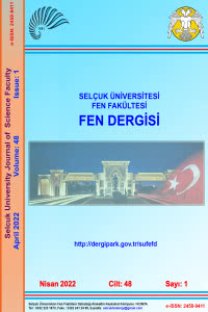EFFECT OF ASPECT RATIO ON THE FREEZING-THAWING OF A CH CLAY
Numune Boyutunun CH Kilinin Donma-Çözülme Üzerindeki Etkisi
___
Altun, S., Sezer, A., Erol, A., 2009, “The Effects of Additives and Curing Conditions on the Mechanical Behavior of a Silty Soil”, Cold Regions Science and Technology, Vol.56, No.2-3, pp. 135-140.An, M., Zhang, L., Yı, Q., 2008, “Size Effect on Compressive Strength of Reactive Powder Concrete”, J. China Univ. Mining & Technology, Vol.18, pp. 279-282.
Andersland O.B., Ladanyi B., 2004, Frozen Ground Engineering, 2nd edn. USA. John Wiley & Sons.
ASTM D 2166, Standard Test Method for Unconfined Compressive Strength of Cohesive Soil, American Society for Testing and Materials, West Conshohocken, Pennsylvania, USA.
ASTM D 698-78, Fundamental Principles of Soil Compaction, American Society for Testing and Materials, West Conshohocken, Pennsylvania, USA.
Bello, A.A., 2011, “Analysis of Shear Strength of Compacted Lateritic Soils”, The Pacific Journal of Science and Technology, Vol.12 No.1, pp. 425-434.
Del Viso, J.R., Carmona, J.R., Ruiz, G., 2008, “Shape and Size Effects on the Compressive Strength of High-Strength Concrete”, Cement and Concrete Research, Vol.38, pp. 386-395.
Felekoğlu, B., Türkel, S., 2010, “Effects of Specimen Type and Dimensions on Compressive Strength of Concrete”, Gazi University Journal of Science, Vol.18, No.4, pp. 639-645.
Ghazavi, M., Roustaie, M., 2010, “The Influence of Freeze-thaw Cycles on the Unconfined Compressive Strength of Fiber-reinforced Clay”, Cold Regions Science and Technology, Vol.61, pp. 125-131.
Gök, G., 2010, Değişik Geometrideki Betonların Basınç Dayanımlarının Çeşitli Su/Çimento Oranlarina ve Çimento Miktarlarına Göre İncelenmesi, Yüksek lisans tezi, Çukurova Üniversitesi, Fen Bilimleri Ensititüsü, Adana.
Gullu, H., Hazirbaba, K., 2010, “Unconfined Compressive Strength and Post-Freeze-Thaw Behaviour of Fine-Grained Soils Treated with Geofiber and Synthetic Fluid”, Cold Regions Science and Technology, Vol.62, pp. 142-150.
Hassini, S., “Some Aspects of Landfill Design”, Mediterranean Conf on Environmental Geotechnology. Cesme, Turkey. Environmental Geotechnology, pp.137-144. 1992.
Hazirbaba, K., Gullu, H., 2010, “California Bearing Ratio Improvement and Freeze-Thaw Performance of Fine-Grained Soils Treated with Geofiber and Synthetic Fluid”, Cold Regions Science and Technology, Vol.63, pp. 50-60.
Hazirbaba, K., Zhang, Y., Hulsey, J.L., 2011, “Evaluation of Temperature and Freeze-Thaw Effects on Excess Pore Pressure Generation of Fine-Grained Soils”, Soil Dynamics and Earthquake Engineering, Vol.31, pp. 372-384.
Hoek, E., Brown, E.T, 1980. Underground Excavations in Rock (No. Monograph).
Kaczynski, R.R., “Scale Effect During Compressive Strength Tests of Rocks”, Proceedings of the Fifth International Congress, International Association of Engineering Geology, 20-25 October 1986, Buenos Aires, Argentina. Volumes 1, 2 And 3. Publication Of: Aa Balkema, 1986.
Koç, V., Şener, S., 2003, “Hafif ve Normal Betondan Yapılmış Çift Konsol Numunelerin Basınç Göçmesinde Boyut Etkisi”, Türkiye İnşaat Mühendisliği XVII. Teknik Kongre ve Sergisi, pp. 137-141.
Kvǽrnǿ, H.S., Ǿygarden. L., 2006, “The influence of Freeze-Thaw Cycles and Soil Moisture on Aggregate Stability of Three Soils in Norway”, Catena. Vol.67, pp. 175-182.
Liu, J., Wang, T., Tian, Y., 2010, “Experimental Study of The Dynamic Properties of Cement- and LimeModified Clay Soils Subjected to Freeze-Thaw Cycles”, Cold Regions Science and Technology, Vol.61, pp. 29-33.
Lu, J., Zhang, M., Zhang, X., Pei, W., Bi, J., 2018, “Experimental Study on the Freezing–thawing Deformation of a Silty Clay”, Cold Regions Science and Technology, Vol. 151, pp. 19-27.
Narsilio, G.A., Santamarina, J.C., 2008, “Terminal Densities”, Geotechnique, Vol.58, No.8, pp.669-674.
Qi, J., Wei, M., Song, C., 2008, “Influence of Freeze-Thaw on Engineering Properties of Silty Soil”, Cold Regions Science and Technology, Vol.53, pp. 397-404.
Sakamoto, R., Shogaki, T., “Effect of Specimen Size on Unconfined Compressive Strength Properties for Natural Clay Deposits”, Proceedings of the Thirteenth (2003) International Offshore and Polar Engineering Conference, May 25-30, 2003.
Swain, R., 1968, “Strength–Size Effects in Brittle Model Tests Simulating Underground Rock Fracture”, The Mining Engineer, Vol.88, pp. 211-214.
Taşpolat, L.T., Zorluer, İ., Koyuncu, H., 2006, “Effect of Waste Marble Powder on Freezing-Thawing of Impermeable Clay Liners”, Technical Research, Vol.2, pp. 11-16.
Toy, S., Yilmaz, S., Yilmaz, H., 2007, “Determination of Bioclimatic Comfort in Three Different Land Uses in the City of Erzurum Turkey”, Building and Environment, Vol.42, pp. 1315-1318.
Wang, D., Ma, W., Niu, Y.H., Chang, X., Wen, Z., 2007, “Effects of Cyclic Freezing and Thawing on Mechanical Properties of Qinghai–Tibet Clay”, Cold Regions Science and Technology, Vol. 48, pp. 34– 43.
Wang, S., Yang, Z. J., Yang, P., 2017, “Structural Change and Volumetric Shrinkage of Clay Due to Freeze-thaw by 3D X-ray Computed Tomography”, Cold Regions Science and Technology, Vol. 138, pp. 108-116.
Wang, S., Yang, P., Yang, Z. J., 2018, “Characterization of Freeze–thaw Effects Within Clay by 3D X-ray Computed Tomography”, Cold Regions Science and Technology, Vol. 148, pp. 13-21.
Xu, J., Ren, J., Wang, Z., Wang, S., Yuan, J., 2018, “Strength Behaviors and Meso-structural Characters of Loess after Freeze-thaw”, Cold Regions Science and Technology, Vol. 148, pp. 104-120.
Yalçın, E., 2013, “Dowel Numunelerinde Boyut Etkisi”, Fırat Üniv. Mühendislik Bilimleri Dergisi. Vol.25, No.2, pp. 129-136.
Yarbaşı, N., Kalkan, E., Akbulut, S., 2007, “Modification of the Geotechnical Properties, as Influenced by Freeze-Thaw, of Granular Soils with Waste Additives”, Cold Regions Science and Technology. Vol.48, pp. 44-54.
Yavuz, H., Sari, D., Varol, M., “Mermer ve Travertenin Tek Eksenli Basınç Dayanımının Belirlenmesinde Boyut ve Şekil Etkisi”, Türkiye III. Mermer Sempozyumu, Bildiriler Kitabı, 209-217, 2001.
Yazıcı, Ş., Sezer, İ.G., 2007, “The Effect of Cylindrical Specimen Size on the Compressive Strength of Concrete”, Building and Environment, Vol.42, pp. 2417-2420.
Zaimoğlu, A.S., 2010, “Freezing-thawing Behaviour of Fine-Grained Soils Reinforced with Polypropylene Fibers”, Cold Regions Science and Technology, Vol.60, pp. 63-65
- ISSN: 2147-9364
- Yayın Aralığı: 2
- Başlangıç: 2013
- Yayıncı: Selçuk Üniversitesi Mühendislik Fakültesi
BİLGİSAYARLI GÖRÜ SİSTEMLERİ İÇİN SİSTEM TASARIMI VE KONTROLÜ
Birkan BÜYÜKARIKAN, İsmail Serkan ÜNCÜ
Dilek Nur ÖZEN, Kemal Çağrı YAĞCIOĞLU
PURIFICATION PHASES OF ZINC SULPHATE SOLUTION OBTAINED FROM NEUTRAL LEACHING PROCESS OF ZINC CALCINE
Ankastre Kiriş Olarak Düşünülen Bir Uçak Kanadının Serbest Titreşim Analizi
KÖMÜR FLOTASYONUNDA FARKLI YAĞLARIN PERFORMANSLARININ KARŞILAŞTIRILMASI
FREE VIBRATION ANALYSIS OF AN AIRCRAFT WING BY CONSIDERING AS A CANTILEVER BEAM
OPTOELEKTRONİK SENSÖR KULLANARAK NEFESTE BULUNAN SU BUHARI ANALİZİNİN ARAŞTIRILMASI
